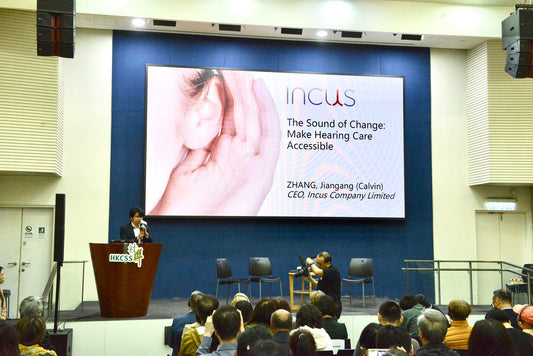
What to Expect From a Hearing Consultation?
Buying hearing aids can be an overwhelming process. What happens at an audiology appointment? You need to know what you should expect from a hearing consultation to protect your interests as a consumer. By understanding the different hearing test types, you can know whether the clinic is providing comprehensive service.
Before buying hearing aids, you should always make an appointment with an audiologist or hearing care professional. The purpose of this hearing consultation is to evaluate your hearing. You do not need to commit to buying hearing aids during the consultation.
Tip: Beware of a sales tactic where the audiologist offers to waive the hearing test fee if you buy hearing aids during the same appointment. Traditional hearing aids are expensive, and you should take time to consider your options before committing to hearing aids.
When booking the audiologist appointment, you should ask them to list the types of hearing tests included in the evaluation.
You can compare that list to the list of recommended hearing test types below. If the hearing clinic only provides the most basic tests, it could be a sign of lack of expertise, or that their goal is to sell as many hearing aids as possible rather than taking time to understand their patient's needs. This comparison also helps you mentally prepare for a hearing test appointment.
List of Hearing Consultation Activities
During the consultation, the hearing care professional should complete most of the following items:
- Case history
- Otoscopy
-
Auditory assessment
- Air & bone conduction
- Recorded word recognition scores
- Speech reception thresholds or speech awareness thresholds
- UCL testing
- MCL testing
- Speech in noise testing
- Review of results
- Referral to a physician for medical clearance (if necessary)
Next, we explain what each of these entails.
Case History

The audiologist will ask questions to learn about your health, including your hearing health. They may ask questions like What brought you here today? Has anyone ever told you that your television is too loud?.
Otoscopy

Otoscopy is a visual inspection of the ear canal. During otoscopy, the hearing care professional examines the ear canal and eardrum using an otoscope. Also known as an otoscopic examination or ear exam, the otoscopy procedure sometimes reveals the hearing loss cause. For instance, the hearing loss could be due to earwax buildup, in which case you should get the earwax removed and may not require hearing aids at all. There are also other potential findings from otoscopy, such as otitis media, which is inflammation inside the ear.
Auditory Assessment

The auditory assessment is what is more commonly known as a hearing test. It should be conducted in a soundproof booth to minimize the effects of background noise on the results. The names of the hearing tests that should be included are:
- Air conduction audiometry
- Bone conduction audiometry
- Recorded word recognition scores (WRS) testing
- Speech reception thresholds (SRT) or speech awareness thresholds (SAT) testing
- Uncomfortable listening level (UCL) testing
Depending on the circumstances, Most Comfortable Level (MCL) testing and/or speech in noise testing may also be required.
To re-emphasize, all or most of the above tests for hearing loss should be included in a comprehensive hearing assessment.
Unfortunately, some hearing care professionals do not follow best practices for hearing assessment. They might only conduct air conduction audiometry and bone conduction audiometry. However, some cases of hearing loss will not be detected by those methods. The ultimate goal of seeking help from a hearing care professional is to find out how to get help to hear better to better communicate with others. That is why it is important to also assess the ability to understand speech.
Only a few specific frequencies are tested in a pure-tone hearing test. Some hearing loss may be undetectable by pure-tone testing. Some patients show no signs of hearing loss during pure-tone testing, but report that they have difficulties understanding what people say. In those cases, speech audiometry might be useful.
The uncomfortable listening level test can help reveal hearing disorders like hyperacusis, indicated by lower tolerance to loud sounds.
These tests are all subjective hearing tests, which mean they require cooperation from the subject. Subjective hearing tests are fine to use with adults and older children, because they can understand instructions. When testing for hearing loss among newborns and babies, however, objective hearing tests are used.
Tip: Before booking an appointment with the hearing care professional, ask them for the names of the hearing tests they provide.
Review of Results

During the consultation, the hearing care professional will generate one or several pages of test results. These will often be in a diagram called an audiogram. The results can be hard to interpret, so the hearing care professional should explain them.
You can also read our article on how to read an audiogram.
Referral to Physician for Medical Clearance

During the consultation, the hearing care professional may discover certain signs of medical conditions. If applicable, they need to make a referral to a physician for further investigation and clearance. Some signs that may require additional follow-up are:
- Visible congenital or traumatic deformity of the ear
- Activate drainage from the ear in the past 90 days
- Sudden hearing loss within the past 90 days
- Reported acute or chronic dizziness
- Unilateral hearing loss of sudden or recent onset within 90 days
- Air-bone gap greater than 15dB at 500Hz, 1 & 2 kHz
- Reported pain or discomfort
- Visible evidence of excessive cerumen or foreign body in the ear
Tip: Some hearing loss is due to medical issues and requires further checking by specialists before any discussion about hearing aids start.
Where Some Audiologist Fall Short
Most clinics would carry out proper case history review, otoscopy and review of results. However, they might not have the equipment or patience to complete all of the hearing test types required for a thorough auditory assessment. Commonly, hearing care providers perform air and bone conduction testing while skipping other tests. Another problem arises when they do not act when seeing the red flags that should trigger a referral to a physician for further evaluation.
In total, a formal hearing test procedure may last 45-60 minutes.
Summary: List of Hearing Test Types
Ensure that the audiologist provides all or most of these hearing test types:
- Case history
- Otoscopy
-
Auditory assessment
- Air & bone conduction
- Recorded word recognition scores
- Speech reception thresholds or speech awareness thresholds
- UCL testing
- MCL testing
- Speech in noise testing
- Review of results
- Referral to a physician for medical clearance (if necessary)
Image attribution: Flávia Costa, CC BY 3.0 <https://creativecommons.org/licenses/by/3.0>, via Wikimedia Commons



